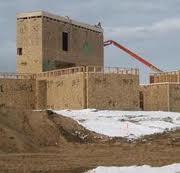Mormon Jerusalem Film Set
Business is about to boom in Goshen, Utah, population not-quite 900. The Church of Jesus Christ of Latter-day Saints, which has owned a sizeable piece of land there for some time, is building a little, new Jerusalem, so to speak.
The Church has accomplished considerable feats of filming in the past, and its newest project is to build a suitable site which can be used for several years to film sequences from the New Testament. After the initial project is complete, the site can be used for other biblical films.
Goshen, located in southern Utah County, is the ideal site for the project, scouts say. It is remote enough to allow filming without the worry of anachronisms like telephone and power lines, the sound of traffic, or crowds of people. The land which will be used for the project was once used to grow alfalfa, grain, corn, potatoes, and tomatoes. Executive producer John Uibel said that, unlike most farmland, which is flat, this site has “lots of rises and dells and hidden places. There’s a small stream that runs through the length of the property.” It even has some sandy dunes! The site in Goshen has already been used to shoot a short pilot film, the Good Samaritan. The Church has extended an invitation for volunteers in a multiple country casting call.
- “Everyone—seasoned actors, amateur performers, even people with no experience at all—is encouraged to participate,” says the official Church News page. The invitation also says, “To help re-create the world of ancient Jerusalem and tell the stories of the New Testament, the studio is looking for individuals who could be made to look as if they’d stepped out of the pages of the New Testament.”
In early 2011, the Church had already begun to recruit actors by looking in the United States, South America, and Europe. More than 10,000 people have been added to the Church’s casting database since the beginning of the project.
One of the difficulties to overcome at the site is the lack of accurate background items, such as palm trees and olive trees. Uibel stated the Church’s digital effects team will need to make several adjustments to about one-third of the stories they wish to film, but probably not as many changes as one would think. An elaborate set is being built to help depict events that took place in Jerusalem and other Biblical cities. The goal is to create “an urban Jerusalem environment,” said Uibel, without actually duplicating the city itself. By creating a network of period buildings out of quality materials, the Church will actually save money in the long run by not simply bulldozing sets again and again, as most filmmakers are forced to do. This will allow the Church to use the set in the future for other projects.
While everything is going to be state-of-the-art, it will not cost nearly as much as one would think. When thinking in terms of Hollywood budgets, the two most expensive things are paying star actors and funding marketing, neither of which the Church will have to worry about.
The ambitious project plans to create a series of complete stories from the New Testament, rather than making a single feature-length film. The stories won’t be tied together by a single plot, or new characters. Rather, the final product will be a collection of New Testament clips which can be used for personal study, broadcast presentations, proselytizing, church teaching, or whatever they are needed for. The clips will be entirely true to the stories out of the King James Version of the Holy Bible. No new dialogue, no new setting—exactly like the history states.
The project is slated to start in June 2011 and to go for 30 days. The Church is still taking applications and video auditions on their website. They are searching for people who have the right look, not necessarily the experience. Leaders of the project are confident in the Utah film community to step up and volunteer.
Some of the first stories they plan to film are Christ’s birth, the Wise Men visiting Jesus and his parents, Jesus’s baptism, Jesus visiting with Nicodemus, Jesus raising the dead daughter of Jairus, and Jesus’s defense of the woman taken in adultery. One story that the Church has never filmed before, but hopes to include in this project is Jesus cleansing the temple. Some of these stories should be ready and to have gone through post production by the end of 2011.
